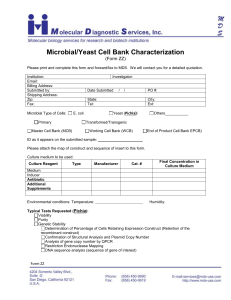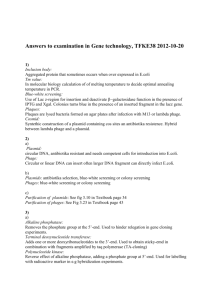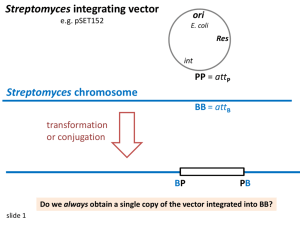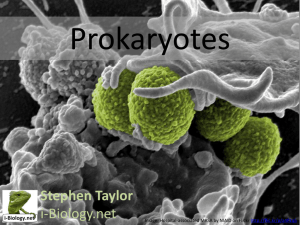Escherichia coli Nicole Kathamegos Faculty Sponsor: William Schwan, Department of Microbiology
advertisement
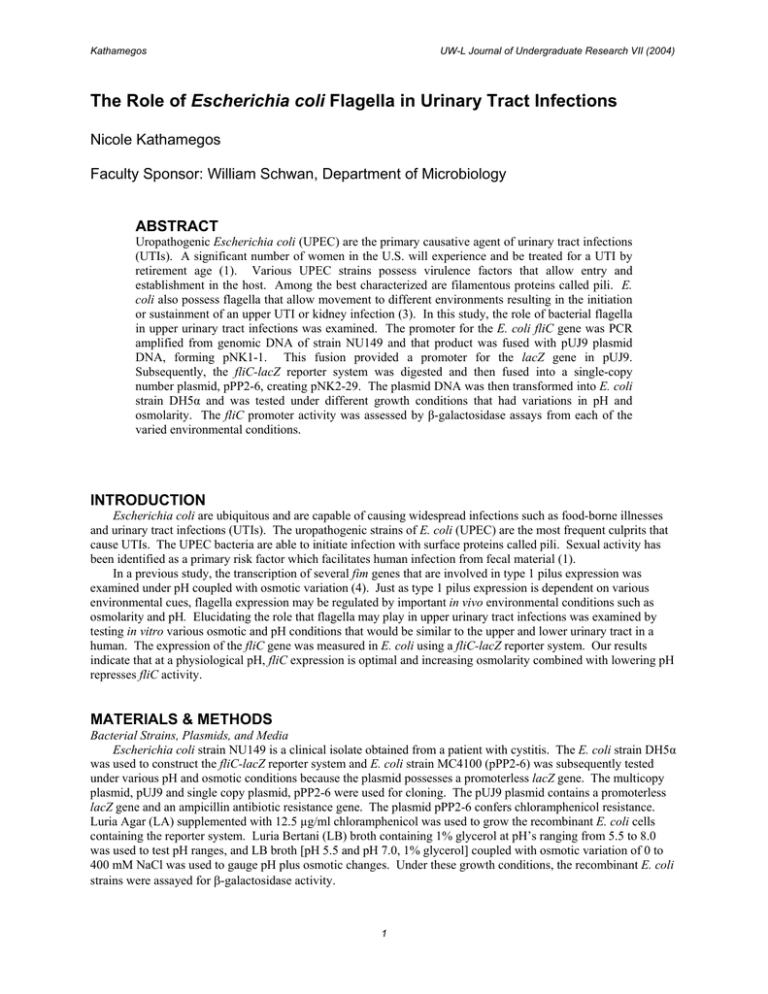
Kathamegos UW-L Journal of Undergraduate Research VII (2004) The Role of Escherichia coli Flagella in Urinary Tract Infections Nicole Kathamegos Faculty Sponsor: William Schwan, Department of Microbiology ABSTRACT Uropathogenic Escherichia coli (UPEC) are the primary causative agent of urinary tract infections (UTIs). A significant number of women in the U.S. will experience and be treated for a UTI by retirement age (1). Various UPEC strains possess virulence factors that allow entry and establishment in the host. Among the best characterized are filamentous proteins called pili. E. coli also possess flagella that allow movement to different environments resulting in the initiation or sustainment of an upper UTI or kidney infection (3). In this study, the role of bacterial flagella in upper urinary tract infections was examined. The promoter for the E. coli fliC gene was PCR amplified from genomic DNA of strain NU149 and that product was fused with pUJ9 plasmid DNA, forming pNK1-1. This fusion provided a promoter for the lacZ gene in pUJ9. Subsequently, the fliC-lacZ reporter system was digested and then fused into a single-copy number plasmid, pPP2-6, creating pNK2-29. The plasmid DNA was then transformed into E. coli strain DH5α and was tested under different growth conditions that had variations in pH and osmolarity. The fliC promoter activity was assessed by β-galactosidase assays from each of the varied environmental conditions. INTRODUCTION Escherichia coli are ubiquitous and are capable of causing widespread infections such as food-borne illnesses and urinary tract infections (UTIs). The uropathogenic strains of E. coli (UPEC) are the most frequent culprits that cause UTIs. The UPEC bacteria are able to initiate infection with surface proteins called pili. Sexual activity has been identified as a primary risk factor which facilitates human infection from fecal material (1). In a previous study, the transcription of several fim genes that are involved in type 1 pilus expression was examined under pH coupled with osmotic variation (4). Just as type 1 pilus expression is dependent on various environmental cues, flagella expression may be regulated by important in vivo environmental conditions such as osmolarity and pH. Elucidating the role that flagella may play in upper urinary tract infections was examined by testing in vitro various osmotic and pH conditions that would be similar to the upper and lower urinary tract in a human. The expression of the fliC gene was measured in E. coli using a fliC-lacZ reporter system. Our results indicate that at a physiological pH, fliC expression is optimal and increasing osmolarity combined with lowering pH represses fliC activity. MATERIALS & METHODS Bacterial Strains, Plasmids, and Media Escherichia coli strain NU149 is a clinical isolate obtained from a patient with cystitis. The E. coli strain DH5α was used to construct the fliC-lacZ reporter system and E. coli strain MC4100 (pPP2-6) was subsequently tested under various pH and osmotic conditions because the plasmid possesses a promoterless lacZ gene. The multicopy plasmid, pUJ9 and single copy plasmid, pPP2-6 were used for cloning. The pUJ9 plasmid contains a promoterless lacZ gene and an ampicillin antibiotic resistance gene. The plasmid pPP2-6 confers chloramphenicol resistance. Luria Agar (LA) supplemented with 12.5 µg/ml chloramphenicol was used to grow the recombinant E. coli cells containing the reporter system. Luria Bertani (LB) broth containing 1% glycerol at pH’s ranging from 5.5 to 8.0 was used to test pH ranges, and LB broth [pH 5.5 and pH 7.0, 1% glycerol] coupled with osmotic variation of 0 to 400 mM NaCl was used to gauge pH plus osmotic changes. Under these growth conditions, the recombinant E. coli strains were assayed for β-galactosidase activity. 1 Kathamegos UW-L Journal of Undergraduate Research VII (2004) PCR Oligonucleotide primers (FliC1 and FliC2) specific for a 397 bp segment of the E. coli strain NU149 fliC promoter were amplified with the BamHI and EcoRI restriction endonuclease sites flanking the DNA promoter sequence. PCR amplification using these primers was set up as follows: an initial denaturation of five minutes, then 35 cycles 1 min at 94ºC, 1 min at 55ºC, and 1 min at 72ºC, finishing with a seven minute elongation at 72ºC after the 35th cycle. Chromosomal DNA from E. coli strain NU149 extracted with a commercial kit served as the template in the PCR. The 397 bp product was visualized on a 0.8% agarose gel containing ethidium bromide with a 1 kb ladder (New England Biolabs) served as the molecular weight standard. Construction of the fliC-lacZ fusion The PCR amplified 397 bp product was passed through a Microcon 30 filter to concentrate the DNA. Subsequently, the DNA was digested with the restriction endonucleases EcoRI and BamHI. The digested DNA fragment was ligated to EcoRI/BamHI digested pUJ9 plasmid DNA and transformed into competent DH5α cells. The resulting transformants were selected for on LA containing 100 µg/ml ampicillin and X-Gal. Blue colonies were screened for β -galactosidase and the plasmid DNA was extracted with a commercial kit (Qiagen, Valencia, CA) to verify the appropriate size. One recombinant plasmid, pNK1-1, was carried further. This plasmid DNA was digested with the restriction endonuclease NotI and ligated to NotI cut pPP2-6 DNA. Following ligation, the DNA was transformed into DH5α and clones were selected on LA containing 12.5 µg/ml chloramphenicol and X-Gal. One clone, pNK2-29, was selected for in vitro analysis. Beta-Galactosidase Assays Beta-galactosidase assays were performed on DH5α/pNK2-29 and MC4100/pPP2-6 cells grown in LB media at various pHs and in the presence and absence of NaCl at pH 5.5 and 7.0 (2). Bacteria were grown midlogarithmically and β-galactosidase activity on the sodium dodecyl sulfate and CHCl3 permeabilized cells. The mean values were calculated from three separate experiments in both bacterial strains. RESULTS As shown in Table 1, β-galactosidase activity increased significantly in E. coli strain DH5α/pNK2-29 as the pH neared 7.0. This suggests that fliC gene expression is optimal near a physiological pH (7.0) compared to the negative control E. coli strain MC4100/pPP2-6. Shifting to acidic pH (5.5) resulted in a decrease in promoter activity which was shown to be significant (P < 0.0005). Moreover, at pH 8.0 promoter activity decreased (P < 0.02). When low and high pHs (5.5, 7.0) were coupled with increased osmotic conditions, as shown in Table 2 and 3, β-galactosidase activity was hindered as osmolarity increased. In both pHs containing 400 mM NaCl, promoter activity decreased (pH 5.5, P < 0.02; pH 7.0, P < 0.001). This suggests that fliC gene expression is repressed by high osmotic conditions. Table 1. Effect of pH on the E. coli fliC gene grown in LB (1% glycerol) media E. coli strain pH β-gal activity (Miller Units) MC4100 (pPP2-6) 5.5 2 ± 1a MC4100 (pPP2-6) 6.0 2±1 MC4100 (pPP2-6) 6.5 2±1 MC4100 (pPP2-6) 7.0 2±1 MC4100 (pPP2-6) 7.5 2±1 MC4100 (pPP2-6) 8.0 2±1 DH5α (pNK2-29) 5.5 288 ± 81.5 DH5α (pNK2-29) 6.0 528 ± 82.5 DH5α (pNK2-29) 6.5 629 ± 114 DH5α (pNK2-29) 7.0 1111 ± 110 DH5α (pNK2-29) 7.5 932 ± 190 DH5α (pNK2-29) 8.0 748 ± 125 a Mean ± standard deviation of at least three separate runs. 2 Kathamegos UW-L Journal of Undergraduate Research VII (2004) Table 2. Effect of osmolarity on the E. coli fliC gene grown in LB [pH 5.5] media E. coli strain NaCl (mM) β-gal activity (Miller Units) MC4100 (pPP2-6) 0 2 ± 1a MC4100 (pPP2-6) 100 2±1 MC4100 (pPP2-6) 200 2±1 MC4100 (pPP2-6) 400 2±1 DH5α (pNK2-29) 0 308 ± 104 DH5α (pNK2-29) 100 338 ± 128 DH5α (pNK2-29) 200 251 ± 68.5 DH5α (pNK2-29) 400 61.7 ± 22.0 a Mean ± standard deviation of at least three separate runs. Table 3. Effect of osmolarity on the E. coli fliC gene grown in LB [pH 7.0] media E. coli strain NaCl (mM) β-gal activity (Miller Units) MC4100 (pPP2-6) 0 2 ± 1a MC4100 (pPP2-6) 100 2±1 MC4100 (pPP2-6) 200 2±1 MC4100 (pPP2-6) 400 2±1 DH5α (pNK2-29) 0 1132 ± 130 DH5α (pNK2-29) 100 806 ± 40.9 DH5α (pNK2-29) 200 689 ± 173 DH5α (pNK2-29) 400 454 ± 71.3 a Mean ± standard deviation of at least three separate runs. DISCUSSION The expression of flagella in E. coli may be regulated by environmental conditions such as pH and osmolarity. Expression of the fliC gene in vitro was optimal at a physiological pH (pH 7.0), a condition most similar to the environment of the bladder (4). High osmotic conditions, similar to those in the kidney or upper urinary tract, repressed the E. coli fliC gene in vitro. Moreover, the effect of low pH (pH 5.5) coupled with high osmolarity (400mM NaCl) resulted in a four-fold decrease in the expression of the fliC-lacZ fusion in E. coli. The implications of these results suggest that there may be a mechanism to repress flagella expression under conditions that are similar to the human upper urinary tract. This mechanism may be beneficial for in vivo survival of uropathogenic E. coli in order to evade the host immune response and sustain infection. Through understanding the environmental conditions that are necessary for regulation of the genes responsible for motility in E. coli, new methods for treating patients with upper urinary tract infections may be found. ACKNOWLEDGEMENTS I would like to thank the University of Wisconsin–La Crosse Undergraduate Research Committee for providing me funding that made this project possible. I would also like to extend thanks to Dr. Schwan for all his guidance and for providing me the opportunity to conduct research in his laboratory. 3 Kathamegos UW-L Journal of Undergraduate Research VII (2004) REFERENCES 1. Mulvey, M. A., J. D. Schilling, J. J. Martinez, and S. J. Hultgren. 2000. Bad bugs and beleaguered bladders: interplay between uropathogenic Escherichia coli and innate host defenses. PNAS. 97:8829-8835. 2. Miller, J. H. 1972. Experiments in molecular genetics. Cold Spring Harbor Laboratory Press, Cold Spring Harbor, N.Y. 3. Schilling, J. D., M. A. Mulvey, and S. J. Hultgren. 2001. Structure and function of Escherichia coli type 1 pili: new insight into the pathogenesis of urinary tract infections. Journ. Infect. Dis. 183:S36-40. 4. Schwan, W. R., J. L. Lee, F. A. Lenard, B. T. Matthews, and M. T. Beck. 2001. Osmolarity and pH growth conditions regulate fim gene transcription and type 1 pilus expression in uropathogenic Escherichia coli. Infect. Immun. 70:1391-1402. 4

